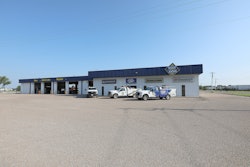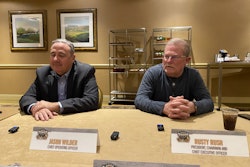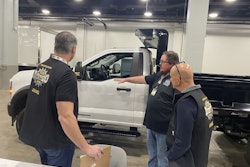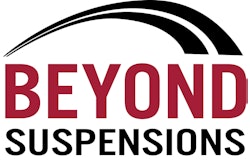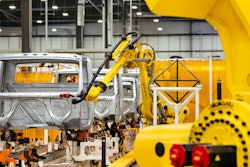
Here’s what you need to know:
- LEDs revolutionized truck lighting with added longevity and durability but are not indestructible.
- Collisions, moisture and electrical problems are key culprits behind LED lamp failures.
- Good thermal management and proactive replacement ensure LED compliance, safety and fleet uptime.
The steady acceptance of light emitting diode (LED) technology in commercial vehicle illumination over the past two decades has fundamentally changed the replacement market for truck and trailer lights.
For many carriers, gone are the days of hastily replacing busted or burned out incandescent bulbs on highway shoulders or rushing to the closest parts counter to get a new bulb before being ticketed by law enforcement or a roadway inspector for a vehicle maintenance or service violation.
LED lamps provide longevity, durability and reduced maintenance for truck owners, freeing them up to spend less time worrying about their vehicle’s visibility and more time focused on hauling freight.
Yet despite their advanced designs and robust housings, LED lamps aren’t everlasting. There are many factors that can lead the diodes in an LED lamp to falter. And similar to incandescent bulbs dimming over time, most LED products remain operational even if individual diodes within a light fail.
[RELATED: What your tire treads can tell you]
As Truck-Lite’s John Hoover, vice president of aftermarket and fleet sales, states, “I’ve found that LED failures almost always stem from factors upstream of the diode itself.”
Being able to identify why a diode has failed enables parts and service experts to better consult customers about their replacement needs.
Impact from collisions
Though LED lamps are far less fragile than their incandescent brethren, no light is impervious to physical damage, which is why Optronics’ Vice President of Sales Dustin Smith states “impact is the No. 1 reason for failure” in LED lamps.
For parts and service providers, he says, it’s important to understand not all collisions are created equal. Backing into a loading dock and shattering a light requires an obvious replacement no matter the lamp type. But LED lamps, because of their durability, can remain operational after minor collisions despite suffering damage that could lead to eventual degradation and failures. That’s where expertise is vital.
A lamp that suffers a cracked housing, damaged weld or weakened adhesive bond, as examples, might continue to work for some time before eventually succumbing to its damage, Smith says. Individual diodes subject to direct impact also may fail while other diodes continue to function.
The longevity of a lamp post-impact depends on its design and severity of the collision.
[RELATED: Trump EPA moves to scrap Biden emission regs]
“If a lens were to crack, that doesn’t mean the LEDs will fail if there is added protection inside the lamp,” says Hoover.
Aftermarket providers who identify damage proactively can warn customers and prevent a future failure event.
Moisture and corrosion can set in over time
Impact damage also can enable moisture access into a lamp and, over time, lead to failure.
LED lamps designed and sold as waterproof or water-resistant are marketed to have incredible life cycles. But Hoover says they only last that long if they remain in peak operating condition. Once a lamp’s protective housing has been breached, it’s only a matter of time before moisture enters the unit.
And sometimes not even directly, as Smith alludes to moisture wicking through a compromised harness directly into a closed lamp. “If [moisture] gets into the rear of the lamp it’s going to go straight to the circuit board,” he says.
In these instances, he says a lamp won’t fail immediately. Corrosion sets in over time (amplified by electrical current), wearing down the wiring, circuit board and diodes at a varied pace depending on the amount of moisture present.
[RELATED: Is manual parts identification crushing your sales team?]
As Grote writes in a technical bulletin, wires that are beginning to corrode “are not good conductors of electricity. As a result, lamps, especially ABS indicator or stop/turn/tail lamps, will flicker or stop working altogether, creating a dangerous and often illegal situation.”
Hoover says the “moment you spot flicker, dimming or dark spots, it’s time for a swap,” while Smith adds, “once the moisture is in there, the lamp is compromised.”
Electrical issues will weaken LED durability
Lights also can be inadvertently damaged by their own power source. Improper voltage to lamps, electrical overstress and reverse voltage can all wear down a lamp prematurely.
Optronics’ Michael Whitman, director of product management, says voltage-related failures are often spotted at the rear of a lamp near the printed circuit board (PCB), where the excessive current enters the unit. LED manufacturers design their lamps to withstand intermittent voltage spikes and corresponding temperature increases in those areas but perpetual and egregious abuse will still lead to failures.
Lighting experts say determining the cause of a voltage shift is the best way to prevent future occurrences and subsequent failures. Sustained overvoltage due to an alternator problem will continue to destroy lamps until the root cause is identified and fixed. Conversely, a lamp made with substandard components unable to manage the voltage requirements within a unit should be replaced a stronger, more robust part.
[RELATED: Distributors tell MEMA what they want from their vendors]
Hoover references “low-grade PCBs, cheap encapsulants or untested connectors that crack, delaminate or corrode under UV and moisture” as possible failure points.
Improper thermal management
Failure to manage heat also can prematurely destroy an LED lamp. Smith says most of the newest LED lamps in the trucking industry are surface mount devices (SMD) designed to dissipate heat equally across a unit, creating a more efficient, robust product.
But each aforementioned breakdown of a lamp’s performance can increase heat within a unit, as can lamps “trapped in unvented enclosures or fitted with subpar heat sinks that let junction temperatures climb,” says Hoover.
Rising temperatures also will increase current flow and generate even more heat in a process called thermal runaway, which Hoover cites as a common generator of diode failures.
“If there’s nowhere for that heat to go, the light will go out all the time,” adds Smith.
The good news here is LEDs require much less energy to illuminate than incandescent bulbs, adds Grote, meaning less heat is generated that needs to be discharged.
It also helps that most fleets and owner-operators understand the risks associated with failed lighting, Smith says, and are unwilling to operate a burned out light once discovered.
“Nobody can afford a ticket nowadays,” he says.
But Hoover adds it’s still valuable to impress upon customers, especially drivers, “light literacy” and how to spot and report even subtle shifts in lamp performance. LED knowledge is the shortest path to saving customers money, he says.
“By aligning lamp engineering, installation best practices and data-backed maintenance, you’ll transform lighting from a reactive headache into a rock-solid uptime asset,” he says.





